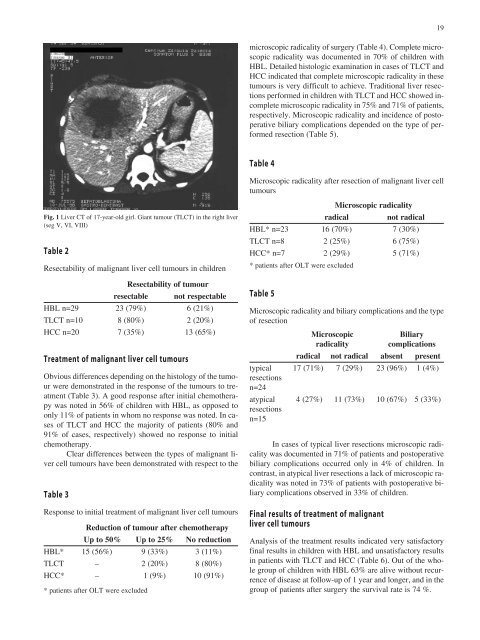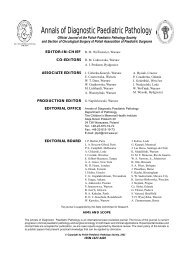annals 1-2.qxd - Centrum Zdrowia Dziecka
annals 1-2.qxd - Centrum Zdrowia Dziecka
annals 1-2.qxd - Centrum Zdrowia Dziecka
You also want an ePaper? Increase the reach of your titles
YUMPU automatically turns print PDFs into web optimized ePapers that Google loves.
microscopic radicality of surgery (Table 4). Complete microscopic<br />
radicality was documented in 70% of children with<br />
HBL. Detailed histologic examination in cases of TLCT and<br />
HCC indicated that complete microscopic radicality in these<br />
tumours is very difficult to achieve. Traditional liver resections<br />
performed in children with TLCT and HCC showed incomplete<br />
microscopic radicality in 75% and 71% of patients,<br />
respectively. Microscopic radicality and incidence of postoperative<br />
biliary complications depended on the type of performed<br />
resection (Table 5).<br />
19<br />
Table 4<br />
Fig. 1 Liver CT of 17-year-old girl. Giant tumour (TLCT) in the right liver<br />
(seg V, VI, VIII)<br />
Table 2<br />
Resectability of malignant liver cell tumours in children<br />
Resectability of tumour<br />
resectable not respectable<br />
HBL n=29 23 (79%) 6 (21%)<br />
TLCT n=10 8 (80%) 2 (20%)<br />
HCC n=20 7 (35%) 13 (65%)<br />
Treatment of malignant liver cell tumours<br />
Obvious differences depending on the histology of the tumour<br />
were demonstrated in the response of the tumours to treatment<br />
(Table 3). A good response after initial chemotherapy<br />
was noted in 56% of children with HBL, as opposed to<br />
only 11% of patients in whom no response was noted. In cases<br />
of TLCT and HCC the majority of patients (80% and<br />
91% of cases, respectively) showed no response to initial<br />
chemotherapy.<br />
Clear differences between the types of malignant liver<br />
cell tumours have been demonstrated with respect to the<br />
Table 3<br />
Response to initial treatment of malignant liver cell tumours<br />
Reduction of tumour after chemotherapy<br />
Up to 50% Up to 25% No reduction<br />
HBL* 15 (56%) 9 (33%) 3 (11%)<br />
TLCT – 2 (20%) 8 (80%)<br />
HCC* – 1 (9%) 10 (91%)<br />
* patients after OLT were excluded<br />
Microscopic radicality after resection of malignant liver cell<br />
tumours<br />
Table 5<br />
Microscopic radicality<br />
radical not radical<br />
HBL* n=23 16 (70%) 7 (30%)<br />
TLCT n=8 2 (25%) 6 (75%)<br />
HCC* n=7 2 (29%) 5 (71%)<br />
* patients after OLT were excluded<br />
Microscopic radicality and biliary complications and the type<br />
of resection<br />
Microscopic<br />
Biliary<br />
radicality complications<br />
radical not radical absent present<br />
typical 17 (71%) 7 (29%) 23 (96%) 1 (4%)<br />
resections<br />
n=24<br />
atypical 4 (27%) 11 (73%) 10 (67%) 5 (33%)<br />
resections<br />
n=15<br />
In cases of typical liver resections microscopic radicality<br />
was documented in 71% of patients and postoperative<br />
biliary complications occurred only in 4% of children. In<br />
contrast, in atypical liver resections a lack of microscopic radicality<br />
was noted in 73% of patients with postoperative biliary<br />
complications observed in 33% of children.<br />
Final results of treatment of malignant<br />
liver cell tumours<br />
Analysis of the treatment results indicated very satisfactory<br />
final results in children with HBL and unsatisfactory results<br />
in patients with TLCT and HCC (Table 6). Out of the whole<br />
group of children with HBL 63% are alive without recurrence<br />
of disease at follow-up of 1 year and longer, and in the<br />
group of patients after surgery the survival rate is 74 %.

















